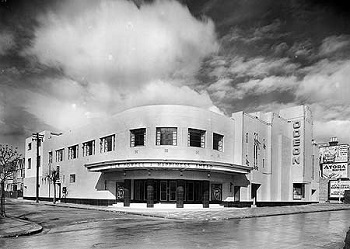Celia Piggott (CP-95-200)

Odeon Wealdstone
Uploaded by Granola. Creative Commons (Attribution) License via cinematreasures.org
In June 1995, Cinema Culture in 1930s Britain Research Fellow Valentina Bold contacted Westminster Nursing Home in the London suburb of Harrow with a view to interviewing residents for the project. Interviews took place there on 5 July and 25 July 1995 and involved five named residents in total, two of whom—Celia Piggott and May Godden--took part in both interviews as core informants.
In the first interview, Westminster Nursing Home residents Norma, John, and Lilian (surnames unrecorded) participated alongside Mrs Piggott and Mrs Godden. Born near King’s Cross in 1910, Mrs Piggott left school at fourteen and stayed at home for a year or so before starting work in the fur trade. She was alone among the Westminster Nursing Home interviewees in having lived in Harrow during the 1930s. Norma was born in Wandsworth in 1904, and left school at the age of fourteen to take up employment as a kitchen maid in a hotel; Lilian, who was born near King’s Cross in 1912, left school at sixteen and worked as a GPO telephonist; John, born in 1914 in Kentish Town, left school at fourteen and eventually became an artisan plasterer who worked on the decoration of Royal properties, including Buckingham Palace. In the first interview, the five participants share relatively vivid memories of visits to music halls, prompting each other in recollecting the names and locations of cinemas in Harrow and elsewhere in London and mentioning the ubiquitous cinema queues and the live acts that featured alongside film screenings. They recall the coming of sound, the rowdy audience behaviour at children’s matinees, and the key role of ‘the pictures’ in young people’s lives as they grew up and started courting. Prompted by the interviewer, they name and discuss a number of film personalities, with agreed favourites including Bette Davis. In the second interview, Mrs Piggott recalls that she used to go to the cinema every week, that she preferred dramatic films, and that one of her favourite stars was Ray Milland, “a gentleman sort of.” She remained a regular cinemagoer until her marriage in the late 1920s, and recalls that during her early married life would sometimes go and see a picture on her own on a Saturday afternoon after finishing the housework. Audio-synced interview (1 of 2)|
Interview transcript | Listing of cinemas, films and stars mentioned
Audio-synced interview (2 of 2)
Interview transcript | Listing of cinemas, films and stars mentioned
Interview transcript | Listing of cinemas, films and stars mentioned
Audio-synced interview (2 of 2)
Interview transcript | Listing of cinemas, films and stars mentioned
Documents, Memorabilia and Related Links
Harrow home pagePlayhouse Cinema, Greenford (cinematreasures site)
Euston Palace of Varieties (arthurlloyd.co.uk site)
S.G. Brown, Engineer (gracesguide site)
Clipping of opening of the Granada Theatre (CM-20-001RP001)